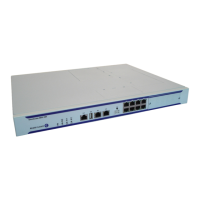Interface Configuration
7750 SR OS Interface Configuration Guide Page 329
vport
Syntax vport name [create]
no vport name
Context config>port>ethernet>access>egress
Description This command configures a scheduling node, referred to as virtual port, within the context of an
egress Ethernet port. The vport scheduler operates exactly like a port scheduler with the difference
that multiple vport objects can be configured on the egress context of an Ethernet port.
The vport is always configured at the port level even when a port is a member of a LAG.
The user applies a port scheduler policy to a vport using the following command:
configure>port>ethernet>acess>egress>vport>port-scheduler-policy port-scheduler-policy-
name
A vport cannot be parented to the port scheduler. The CLI will not allow the user to apply a port
scheduler policy to a vport if one has been applied to the port. Conversely, the CLI will not allow the
user to apply a port scheduler policy to the egress of an Ethernet port if one has been applied to any
vport defined on the access egress context of this port. It is thus important the user ensures that the
sum of the max-rate parameter value in the port scheduler policies of all vport instances on a given
egress Ethernet port does not oversubscribe the port? rate.
SAP and subscriber host queues can be port-parented to a vport scheduler in a similar way they port-
parent to a port scheduler.
Parameters name — Specifies the name of the vport scheduling node and can be up to 32 ASCII characters in
length. This does not need to be unique within the system but is unique within the port or a LAG.
host-match
Syntax host-match dest description-string [create]
no host-match dest destination-string
Context config>port>ethernet>access>egress>vport
Description This command specifies the destination and organization strings to be used for matching subscriber
hosts with this vport.
The parent vport of a subscriber host queue, which has the port-parent option enabled, is determined
by matching the destination string dest string associated with the subscriber and the organization
string org string associated with the subscriber host with the strings defined under a vport on the port
associated with the subscriber.
If a given subscriber host queue does not have the port-parent option enabled, it will be foster-
parented to the vport used by this subscriber and which is based on matching the dest string and org
string. If the subscriber could not be matched with a vport on the egress port, the host queue will not
be bandwidth controlled and will compete for bandwidth directly based on its own PIR and CIR
parameters.
By default, a subscriber host queue with the port-parent option enabled is scheduled within the
context of the port’s port scheduler policy.

